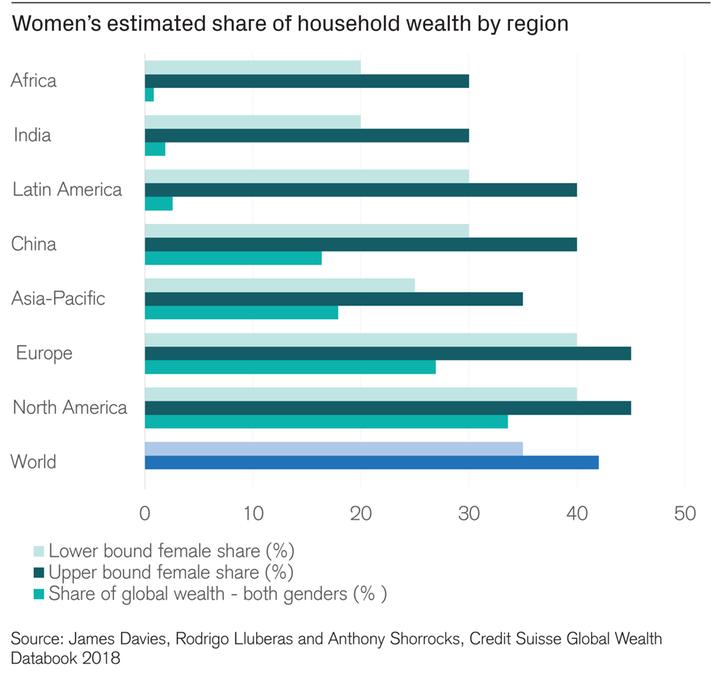This estimate is higher than presented in some previous studies due to the inclusion of non-financial assets, which not only make up half of global household wealth but are also more equally shared between men and women. Bear in mind also that this estimate is a global average and that there are significant differences among regions.
According to an article based on the chapter “Women and wealth” by James Davies and Anthony Shorrocks published in the Global Wealth Report 2018:
Forces behind the changes in women's wealth
The increase in women's wealth has been fuelled by the lifestyle changes that have occurred over the past century. Getting more education, pursuing a career, combining employment with a family life – these are just some factors that have enabled women to enjoy greater financial independence, earn more, and save more as a result.
On the other hand, there are some forces stalling or reversing this progressive trend. For example, the continued gender pay gap results in smaller wealth accumulation prospects for women. This century has already seen some of these negative factors stopping the trend in several countries.
Regional differences
The available data leads us to conclude that women's share of wealth in both Europe and North America is likely to be in the 40%–45% range. This figure is a strong indication of the share of women globally: Europe and North America host only 17% of world adults, but together they account for 61% of global wealth.
With regard to the rest of the world, recent studies for Africa and India indicate a significantly lower women's share, ranging between 20% and 30%.
The wealth share in China is higher than in Africa or India, but below the level in Europe or North America. We estimate that the overall share of wealth of female adults in China is between 30% and 40%.
According to the data, the Asia-Pacific region (excluding China and India) is very heterogeneous. In some countries the wealth situation of women is similar to that in India (e.g. Pakistan and Bangladesh). However, other countries are closer to China. We assess the women's share in the region at between 25% and 35%.
Finally, studies in some Latin American countries indicate a small gender wealth gap, but, for the region as a whole, the women's share is below that in Europe and North America. We believe it is in the same 30%–40% range as China.
Combining these figures places women's share of global wealth in the range of 35%– 42%, or 40% in round numbers.

Female billionaires
Unsurprisingly, Europe and North America have the highest fractions of female billionaires. Latin America, Africa, Asia-Pacific, and China come next. The figure for Africa may be misleading due to the small sample size: There are only 21 billionaires, of which just two are female.
Among major countries, Germany has the largest female fraction among its billionaires (26.0%), followed by Sweden (25.0%), Switzerland (23.8%), and Australia and India (both 18.6%). Among countries with at least 20 billionaires, Indonesia, Singapore, and Taiwan stand out with zero female billionaires.
According to the global rich lists provided by Bloomberg, Forbes, and Hurun, women are well represented among the many billionaires in China. Hurun even claims that two-thirds of the world's self-made billionaire women are Chinese.
The younger generation
The millennials have had a more difficult start to the adulthood than their predecessors. The adverse circumstances, including the global financial crisis, technological change, and high house prices, have slowed down their pace of wealth accumulation.
Interestingly, young women have been less severely affected than men. This may be due to the fact that the industries most impaired by the financial crisis and the global recession that followed tended to be male-dominated – finance and construction, for example – while the more stable parts of the economy were not – education, health care, and public administration, to name a few.
Women investment behaviour
Our research confirms that women are more risk averse than men, demonstrate less investment knowledge, and feel less confident when making investment decisions.
Their investment styles translate into their portfolio composition. The data from Europe and the US show that women hold more of their assets in non-financial form and have a smaller fraction of their financial assets in more risky forms (stocks and mutual funds).
The other common perception that women tend to save more is not supported by our research. Although women could be expected to save more given the fact that they live longer, they spend more on their children than men do, which adversely affects their saving.
Improvements are not universal
Women's share of wealth rose significantly during the 20th century, and their wealth levels have risen in sync with all household wealth since the year 2000. There are also signs that more self-made women are succeeding in business and entering the highest wealth ranks.
However, improvements in women's wealth situations are not universal. There are large gender wealth gaps in some regions. And even in the countries where progress is the strongest, some categories of women – for example, single mothers and divorcees – remain handicapped.
While there are signs that progress has been happening in much of the world, more needs to be done to ensure that women have an equal opportunity to build up, inherit, and share in wealth.
Recommended for you:
Tax transparency and compliance top priorities for Asia HNWIs, not secrecy
Less than half of young Chinese have started saving for retirement
AIA Singapore empowers its next-generation insurance agency with one-stop multi-purpose digital tool
Follow Asia Advisers Network on Facebook, Twitter and YouTube.